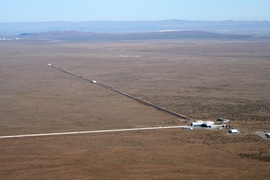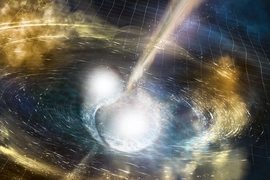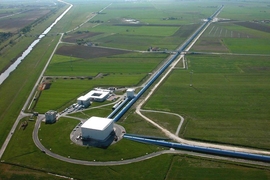It’s been just three weeks since LIGO resumed its hunt for cosmic ripples through space-time, and already the gravitational-wave hunter is off to a running start.
One of the detections researchers are now poring over is a binary neutron star merger — a collision of two incredibly dense stars, nearly 500 million light years away. The power of this stellar impact set off gravitational waves across the cosmos, eventually reaching Earth as infinitely small ripples that were picked up by LIGO (the Laser Interferometer Gravitational-wave Observatory, operated jointly by Caltech and MIT), as well as by Virgo, LIGO’s counterpart in Italy, on April 25 at 4 a.m. ET.
Researchers have determined that the source of the gravitational wave signal is likely a binary neutron star merger, which they’ve dubbed #S190425z. This is the second time that LIGO has discovered such a source.The other neutron star merger, detected in 2017, was also the first event captured by LIGO that was also observed using optical telescopes. As astronomers around the world pointed telescopes at this first neutron star merger, they were able to see the brilliant “kilonova” explosion generated as the two stars merged. They also detected signatures of gold and platinum in the aftermath — direct evidence for how heavy elements are produced in the universe.
With LIGO’s new detection, astronomers are again pointing telescopes to the skies and searching for optical traces of the stellar merger and any resulting cosmic goldmine.
MIT News caught up with Salvatore Vitale, assistant professor of physics at MIT and a member of the LIGO Scientific Collaboration, about this newest stellar discovery and hints of even more “cosmic whispers” on the horizon — including the tantalizing possibility that LIGO has also captured the collision of a black hole and a neutron star.
Q: Walk us through the moment of discovery. When did this signal come in, and what told you that it was likely a binary neutron star merger?
A: The signal hit Earth at 4:18 a.m. EDT. Unfortunately, at that time the LIGO detector in Hanford, Washington, was not collecting data. The signal was thus detected by the LIGO instrument in Baton Rouge, Louisiana, and the Virgo detector in Italy. Having only two detectors online did not affect our confidence of it being real, since neutron star binaries spend more than one minute in our detectors and these kinds of very long chirps cannot easily be confused with instrumental artifacts or other sources of noise. Similarly, we were able to measure extremely well the mass of the source, which told us it was a binary neutron star, the second ever detected by LIGO and Virgo.
The main consequence of only having two detectors online was that it hurt our ability to localize the source in the sky. The sky map we sent out had a very large uncertainty, over 10,000 square degrees, which is a huge area to follow up, if you are looking for an electromagnetic counterpart.
Q: Since the notice from LIGO went out, astronomers have been training telescopes on the sky. What have they been able to find about this new merger, and how is it different from the one LIGO detected in 2017?
A: When two neutron stars smash one against the other, they trigger a cataclysmic explosion that releases huge amounts of energy and creates some of the heaviest elements in the universe (gold, among others). Finding both gravitational and electromagnetic waves can tell us about the environment in which these systems form, how they shine, their role in enriching galaxies with metals, and about the universe. This is why we routinely and automatically send public alerts to astronomers, so that they can try to identify the sources of our gravitational-wave events.
This is challenging for S190425z, since it has been localized poorly (compare 10,000 square degrees for S190425z with 30 square degrees for the first binary neutron star merger, GW170817). Another important difference is that S190425z was nearly four times further away. Both these factors make it harder to successfully find an electromagnetic counterpart to S190425z. You want to scan a much larger area, and you want to find a weaker and more distant source. This doesn’t mean that astronomers are not trying hard! In fact, in the last 36 hours there have been dozens of observations. So far nothing too convincing, but a lot of excitement! It is nice to see the broader community so engaged with the follow-up of LIGO and Virgo’s events.
Q: Since it started its newest observing run, LIGO has been detecting at least one gravitational wave source per week. What does this say about what sort of extreme phenomena are happening in the universe, on a daily basis?
A: The last few weeks have been incredibly exciting! So far we are making discoveries at roughly the rate we were expecting: one binary black hole a week and one binary neutron star a month. This confirms our expectations that gravitational waves can really play a major role in understanding the most extreme objects of the universe.
It also says that it is not uncommon that two stellar-mass black holes merge, which was not obvious at all before LIGO and Virgo discovered them. We still don’t know if the black holes pairs we are seeing had been together their whole cosmic life, first as normal stars, then as black holes, or if instead they were born separately and then just happened to meet and form a binary system. Both avenues are possible, and with a few more tens of detections we should be able to tell which of these two scenarios happens more often.
Then there is always the possibility of detecting something new and unexpected! As I started drafting these answers, we detected #S190426c, which, if of astrophysical origin, could be the first neutron star colliding into a black hole ever detected by humans. We will know more in the next few weeks, and we will keep listening for these faint and remote cosmic whispers.









